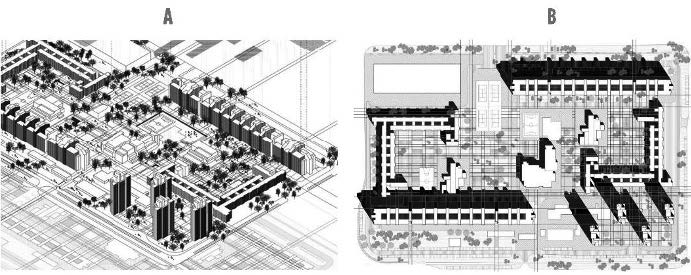Between Imagined, Realized, and Lived Space
Downloads
DOI:
https://doi.org/10.51588/eaaeacp.54Keywords:
workshop, architectural design, architectural programming, urban studies, modernityAbstract
The subject of this paper is twofold (1) towards review and revision of extra-curricular learning model in the form of a student workshop as an extended environment and a reflective arena, and (2) towards generating workshop content aimed at examining modernity in contemporary conditions of urban transformation. The paper is structured in three parts. The first part introduces the concept of an architectural workshop with a discussion of general methodological perspectives that shape this approach that takes place through three continuous stages during which students develop the process of analytical thinking, architectural programming and architectural design. The second part of the paper contextually and conceptually position the content of the workshop aimed at examining modernity in contemporary conditions of urban transformation between imagined, realized, and lived space. The third section introduces the content of two student workshops as an illustrative example of the implementation of methodology with specified assignments and substance.
How to Cite
Published
Issue
Section
License
Copyright (c) 2020 Aleksandra Milovanović, Anica Dragutinović, Jelena Ristić Trajković, Ana Nikezić

This work is licensed under a Creative Commons Attribution 4.0 International License.
References
Blagojevic, Lj. (2007) Novi Beograd — Osporeni modernizam, Beograd, Zavod za udžbenike. (In Serbian)
Djorđevic, A. (1972) Ekspoze povodom usvajanja Generalnog urbanističkog plana 1972, Urbanizam Beograda, 19: 13–19. (In Serbian)
Dragutinovic, A., Pottgiesser, U., De Vos, E., Melenhorst, M. (2018) Modernism in Belgrade: Classification of Modernist Housing Buildings 1919–1980, IOP Conference Series: Materials Science and Engineering, Volume 245 (2017) 052075, IOP Publishing, doi:10.1088/1757–899X/245/5/052075
Dragutinovic, A., Pottgiesser, U., Melenhorst, M. (2019) The Minimum Dwelling: New Belgrade Flat and Reflections on the Minimum Today, in M. Melenhorst, U. Pottgiesser, T. Kelllner, F. Jaschke (ed.), 100 YEARS BAUHAUS: What interest do we take in Modern Movement today?, Hochschule OWL (University of Applied Sciences) DOCOMOMO Deutschland e.V., 2019.
Dutton, T. A. (1991) The hidden curriculum and the design studio: Toward a critical studio pedagogy, in Dutton, T.A. (Ed.) Voices in architectural education: Cultural politics and pedagogy. New York: Bergin & Garvey, pp. 165–194.
Dutton, T.A. (1987) Design and Studio Pedagogy, Journal of Architectural Education, 41(1), pp. 16–25.
Gamble, M.E., Dagenhart, R. & Jarrett, C. (2002) Rethinking Studio Pedagogy: Teaching Introductory Architectural Design at the Graduate Level, Proceedings of the 18th National Conference on the Beginning Design Student, pp. 173–178.
Milovanovic, A. (2018) Treći Beograd: pregled razvoja urbanističke misli i delovanja u periodu od 1921. godine do danas, Arhitektura i urbanizam, 45, 16–25. (In Serbian)
Nikezic, A., Ristić Trajkovic, J., Milovanovic, A. (2019) Urban-Rural Synergy Between Housing Spatial Patterns and Landscape: Typological Classification of Belgrade Socialist Settlements from an Environmental Perspective. In: A. Krstić-Furundžić, A. Đukić (Eds.). Handbook of Research on Urban-Rural Synergy Development Through Housing, Landscape, and Tourism, Hershey, PA: IGI Global. pp. 115–137.
Pena, W., Fock, J. (1969) Problem Seeking. New Directions in Archltectural Programming. Caudill, Rowlett and Scott, Houston, Tex. Architects.
Salama, A. M. & Wilkinson, N. (eds.) (2007) Design Studio Pedagogy: Horizons for the Future. Urban International Press
Schenkman, A.S. (1955) The Workshop Idea Exported. The Journal of Higher Education, 26(6): 305–341.
Schön, D. (1984) The architectural studio as an exemplar of education for reflection-in-action, Journal of Architectural Education, 38(1), pp. 2–9.
Schön, D. (1991) The Reflective Practitioner. Ashgate.
Silverstein, M., Jacobson M (1978). Restructuring the hidden program: Toward an architecture of social change. In W. Preiser (Ed.), Facility Programming. Stroudsburg, PA: Dowden, Hutchinson and Ross.
Zeisel, J. (1981) Inquiry by Design: Tools for Environment-Behaviour Research. Cambridge University Press.





